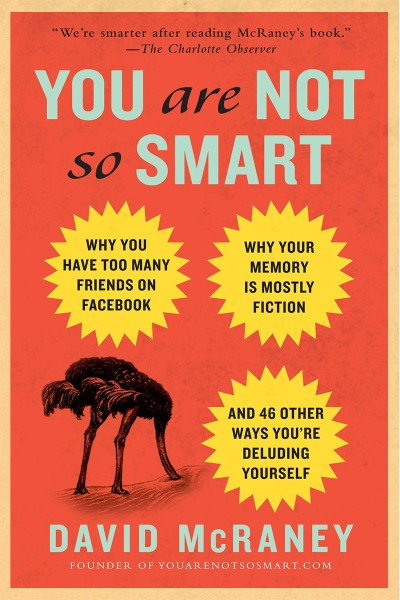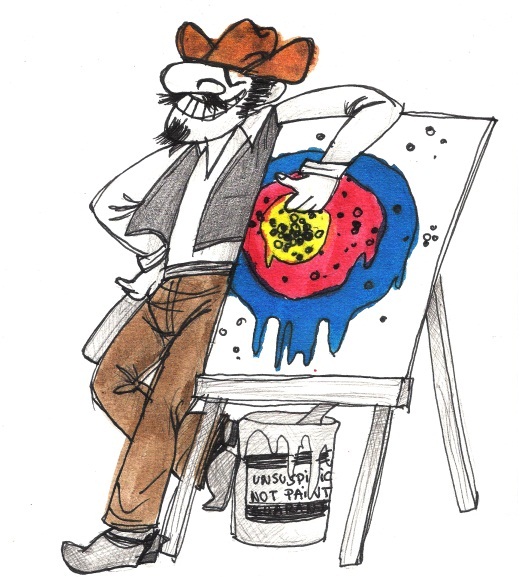
Earlier this year I was recommended this book, the subtitle of which immediately got my attention: Why you have too many friends on Facebook, why your memory is mostly fiction, and 46 other ways you're deluding yourself.
It's a book about three common psychological phenomena: cognitive biases, heuristics, and logical fallacies. Before reading this book I was familiar with cognitive biases but didn't have much of an idea what heuristics and logical fallacies were. In case you are unclear:
Cognitive biases: predicable patterns of thought and behavior that lead you to draw incorrect conclusions
Heuristics: mental shortcuts you use to solve common problems. They speed up processing in the brain, but sometimes make you think so fast you miss what is important.
Logical fallacies: these are like math problems involving language, in which you skip a step or get turned around without realizing it.
I might have been first introduced to the idea of humans thinking and behaving in ways which we don't really understand in Richard Dawkins' The Selfish Gene (the premise of which is that we don't know why we do what we do, and that our actions are actually the moment-to-moment expression of our genes.) You Are Not So Smart takes a similar approach, described here by the author:
There is a growing body of work coming out of psychology and cognitive science that says you have no clue why you act the way you do, choose the things you choose, or think the thoughts you think. Instead, you create narratives, little stories to explain away why you gave up on that diet, why you prefer Apple over Microsoft, why you clearly remember it was Beth who told you the story about the clown with the peg leg made of soup cans when it was really Adam, and it wasn’t a clown.
Three Examples
This book is composed almost like one which you'd find on a coffee table: it is piecemeal, disparate parts. There are a few dozen chapters, each devoted to a single principle like The Texas Sharpshooter Fallacy, The Anchoring Effect, The Dunbar Number, and 45 others. Here are three examples:
Example #1: The Texas Sharpshooter Fallacy

"The fallacy gets its name from imagining a cowboy shooting at a barn. Over time, the side of the barn becomes riddled with holes. In some places there are lots of them, in others there are few. If the cowboy later paints a bull’s-eye over a spot where his bullet holes clustered together, it looks like he is pretty good with a gun. By painting a bull’s-eye over a cluster of bullet holes, the cowboy places artificial order over natural random chance. If you have a human brain, you do this all of the time. Picking out clusters of coincidence is a predictable malfunction of normal human logic."
"When reality shows are filmed, the producers have hundreds of hours of footage. When they condense that footage into an hour, they paint a bull’s-eye around a cluster of holes. They find a narrative in all the mundane moments, extracting the good bits and tossing aside the rest. This means they can create any orderly story they wish from their reserves of chaos. Was that one girl really a horrific bitch? Was that guy with the gelled hair and fake tan really that dumb? Unless you can pull back and see the entire barn, you’ll never know."
Example #2: The Forer Effect
"The tendency to believe vague statements designed to appeal to just about anyone is called the Forer effect, and psychologists point to this phenomenon to explain why people fall for pseudoscience like biorhythms, iridology, and phrenology, or mysticism like astrology, numerology, and tarot cards. The Forer effect is part of a larger phenomenon psychologists refer to as subjective validation, which is a fancy way of saying you are far more vulnerable to suggestion when the subject of the conversation is you."
Example #3: Learned Helplessness
"When you are able to succeed at easy tasks, hard tasks feel possible to accomplish. When you are unable to succeed at small tasks, everything seems harder."
Favorite Passages
"You are always of two minds at any one moment— the higher-level rational self and the lower-level emotional self. You feel like a single person with a single brain, but in many ways, you really have two. Thoughts, memories, and emotions cascade throughout the whole, but some tasks are handled better by one side than the other."
"Coca-Cola stumbled onto the power Santa Claus has to prime you during the holidays. Thoughts of childhood happiness and wholesome family values appear in your subconscious as you choose between Coke or a generic brand of soda. Grocery stores noticed an increase in sales when the smell of freshly baked bread primed people to buy more food. Adding the words “all natural” or including pictures of pastoral farms and crops primes you with thoughts of nature, dissuading thoughts of factories and chemical preservatives."
"It turns out, for any plan to work, every team needs at least one asshole who doesn’t give a shit if he or she gets fired or exiled or excommunicated. For a group to make good decisions, they must allow dissent and convince everyone they are free to speak their mind without risk of punishment."
"You compete with your peers by one-upping them. You attain status by having better taste in movies and music, by owning more authentic furniture and clothing. There are 100 million versions of every item or intellectual property you can own, so you reveal your unique character through how you consume. Having a dissenting opinion on movies, music, or clothes, or owning clever or obscure possessions, is the way middle-class people fight one another for status. They can’t out-consume one another because they can’t afford it, but they can out-taste one another."
"Punditry is an industry built on confirmation bias. Rush Limbaugh and Keith Olbermann, Glenn Beck and Arianna Huffington, Rachel Maddow and Ann Coulter— these people provide fuel for beliefs, they pre-filter the world to match existing world views. If their filter is like your filter, you love them. If it isn’t, you hate them. You watch them not for information, but for confirmation."
Conclusion

The content in this book is fantastic, evidenced by the 97 highlights which I took through reading it. However, as good as the content is, it does not flow like a normal book. Instead of having a beginning, a middle and an end, it is a single chapter dedicated to each of the 48 psychological principles described. This format made me feel like I was reading a coffee table book without pictures.
The examples offered by the author make everything highly relatable, and you might hear things you often do without thinking described in this book. And in the end, that is its intention: to shine a spotlight on things that you do without thinking and provide the opportunity to look at them in another way.
I will never see the Coca-Cola Santa Claus without thinking about implicit memory and priming.
Rating:


